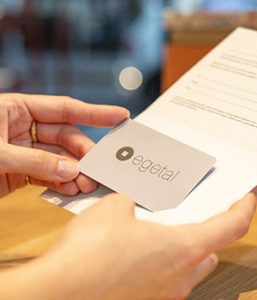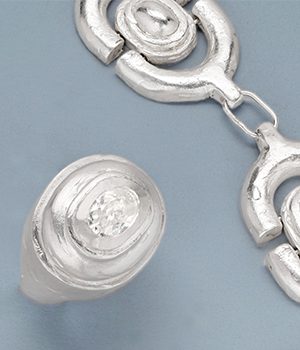Katheryn Leopoldseder on the Abbotsford Convent, contrast and Jazzy Jewellery…


What was the first piece of jewellery you ever made?
When I was about ten years old I was given a gold box chain with a little heart on it. It was continuously breaking and I would lever the links back together with some blunt scissors. In about Grade 5 my best friend and I would peel the plastic off rubbish ties—it was very sophisticated work—and thread beads onto them, making them into rings and earrings and whatnot. Her and I went into business together, we were holding market stalls under the title of “Jazzy Jewellery.” We had a big sign with glitter glue on lilac craft board. I don’t think you could deny my commitment when I single-handedly dragged a trestle table to the bus stop and took it on the bus to my stall at the market.
How old were you…?
This would have been about Year 7, so 12 or so…it was made out of chipboard so it wasn’t exactly light. I don’t know how I did it or why I did it. Or why I didn’t just ring the market and ask if they supplied trestle tables…
Later at high school I had a great metal work teacher, Brent Moncrief, who had studied at RMIT. I think he knew more than I did what my talents were and he nurtured that, helping me to make what I wanted to make and supporting me. When I was in Year 11 he arranged a kind of ‘work experience’ for me at RMIT so I went and pretended that I was a student in the gold and silversmithing course for a few weeks. When I finished high school I was accepted into RMIT Gold and Silversmithing. Looking back at the things that I’ve done and the decisions I’ve made it’s obvious that everything has led me to this point.
And after university?
I was already making because I was working and supporting myself by working part time at a jewellery store and I was making bits and pieces and doing repairs for them while I was at uni. I graduated in a really motivated and dynamic class and we had lots of group exhibitions and continued to have them after we finished studies. A group of about six or seven of us started a studio in High Street, Northcote called Forepaw. Then I did the NEIS Scheme, with the aim to derive a living from jewellery-making alone. From then on I worked for myself full time.

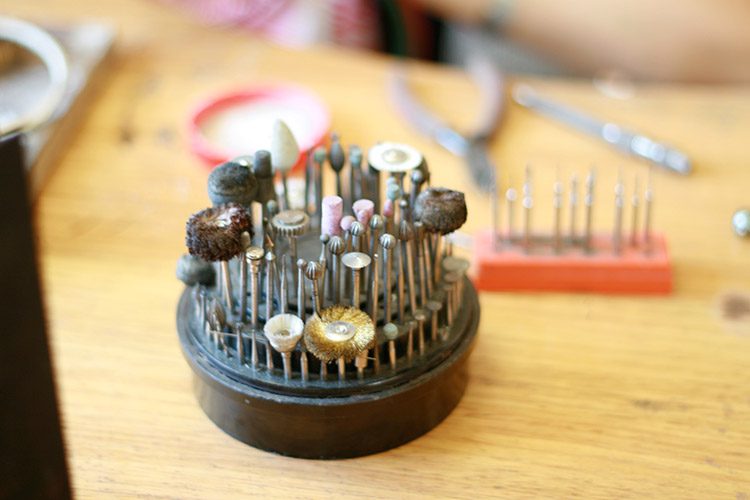
How would you describe your jewellery-making process?
It varies enormously. I always think that maybe it should be more ordered but I’d probably just be happier if I accepted it as it is. It also depends on the brief. I make some jewellery that is very accessible to the public and allows me to exercise my design and manufacturing skills without getting too carried away. I allow myself to really enjoy the process of creating and each completed piece gives way to the next idea. I usually work on four or five pieces at once and they are all influencing each other. Also, now that I’m a Mum, time is stretched so I’m rarely able to sketch or experiment. I am always designing in my mind, so by the time I reach my studio (which I work in two days a week) there is an explosion of activity.
My exhibition work is a bit less restrained. It can be exhausting and laborious and I’m never quite sure if it’s going to come together until the last few minutes of construction.
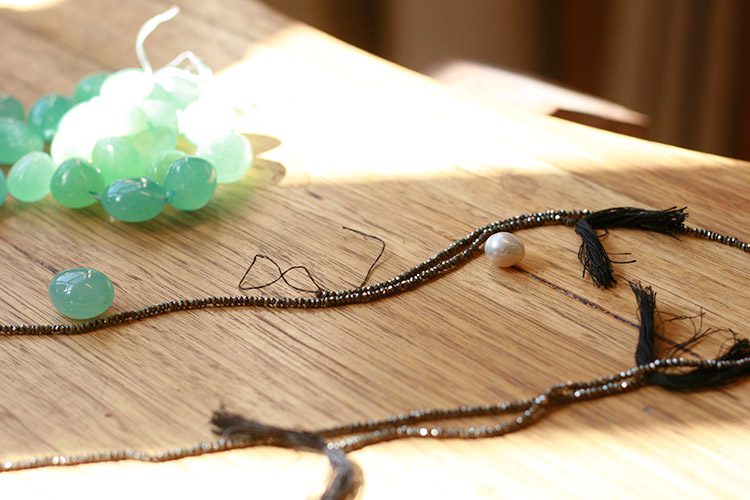
What determines the techniques you employ?
I really allow the finished product to dictate the techniques and processes required and then I go about equipping myself with the skills I need. I use traditional techniques like saw piercing, soldering, forming, filing, doming, lost wax et cetera, but I’ve also explored less conventional approaches like cutting plastic with a knife tool in a press or laser cutting.
When did you move into your studio at the Abbotsford Convent?
About five years ago. I think I’m one of the most fortunate jewellers in Melbourne. I share a beautiful studio with the talented Phoebe Porter. Our studio occupies what was formerly part of the lower laundry precinct, it’s rich with history; there’s lots of beauty to be found in the architecture and the gardens. There are actual real-life animals and there are a lot of creative people in the vicinity. I feel like we’ve set up the studio to be a very functional space. I now really realise how valuable investing that time and money is in making your space work for you.
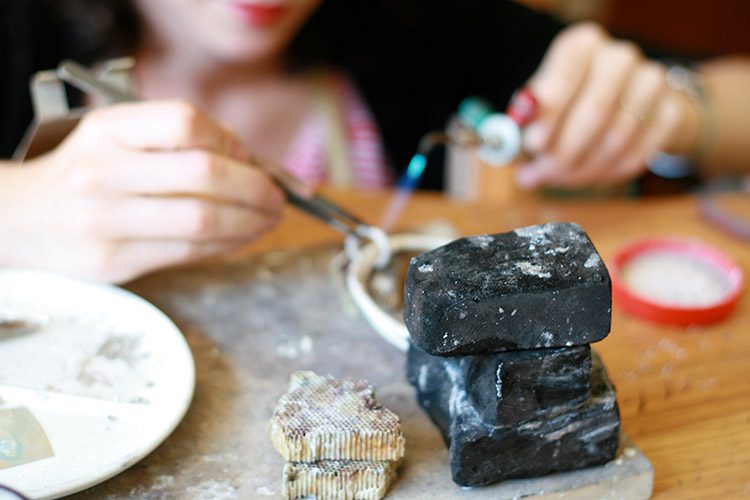
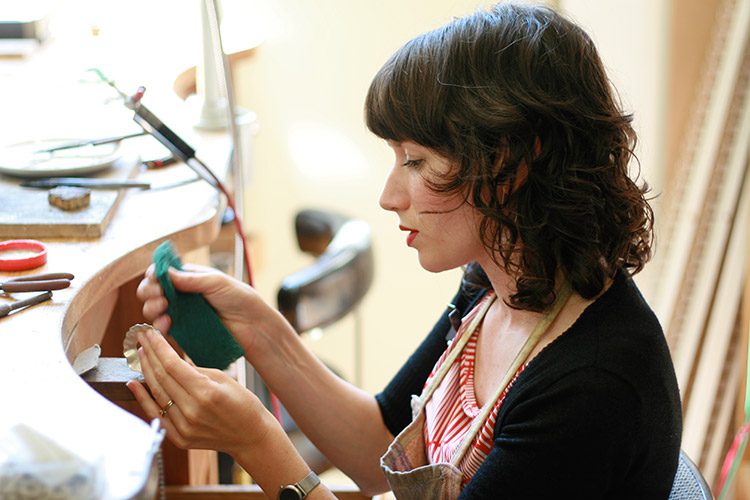
Has it had an influence on your creative process?
…I don’t think I’m fully aware of it yet. I guess if I’m stuck with a concept or I’m working on something I can just call in on an artist in the building and get their feedback, which is invaluable. I think being in this thriving environment always pushes me to reach higher creative resolutions, because I’m not making work in isolation. I’m working in proximity to and with people from lots of different disciplines so I’m more likely to find solutions I may not have thought of if I was in a purely jewellery-minded environment.
Has the environment you’re in also influenced conceptual or thematic considerations in your work?
I think it’s complemented them. When I came out of university I was really exploring the idea of looking for a sense of home, a sense of stability, so I was interpreting that as a place, as architectural motifs. I started to make jewellery that reflected the architectural themes of the area as a way of grounding myself, I suppose. The wrought iron in my work came about when I lived in Richmond with lots of terrace houses. In a few of my pieces I’ve been exploring concepts of “the internal” or somewhat religious or spiritual ideas. I think I probably would have done that any way, but this environment has certainly contributed to, or really complemented, that work. The convent has been a great place to exhibit that work. Given the convent’s religious past, the work has seemed appropriate. The convent’s very different now compared to its past life, I mean now there’s a pub in the nuns’ bedroom…but, yeah, it’s been the right place and the right time for it. Looking at a sense of home and then later exploring that in a spiritual context I think is probably a part of the same conversation.
What would you say links your work together?
I’m not sure that there is a lot of linking going on. I’ve always liked contrasts: oxidized surfaces against polished metal, faceted stones against the quiet lustre of a pearl, black against white…I am interested in beauty for the sake of it. However I’m also interested in how to achieve this in a sustainable way. I am most interested in human beings, the ironic things we do, the way we fail each other and how amazing we are at the same time. I am interested in exploring what is eternal as opposed to what degrades or perishes and which of these two notions each of us invests in during our lives.
Where is your work heading aesthetically?
I recently travelled to India and came back with lots of stones. I’d like to play with a bit more colour. I brought back a whole lot of rose cut diamonds, that are all really irregular sizes and they have beautiful flat backs so they have a very low profile if you were to sit them in a ring. If I’m making lots of stacked jewellery then each element, given the low profile of the stone, can swivel over the top of the stone. And I brought back a lot of sort of glitter-y, faceted stones but in, I suppose, very “Melbourne” kind of colours…
Like, grey and black? And charcoal?
Not quite, but I suppose I’m going for more opulent pieces maybe, or maybe more luxurious, but in keeping with the style I’ve developed.
…developments inspired by India?
Yes, I think it’s a continuation of the sort of forms that I’ve developed that can be seen in pieces at e.g.etal, but I suppose inspired by a more Indian style…
What was the reason for your trip to India?
I travelled to India at the end of 2010 after a piece [For God so loved the world…] I’d previously made for the Blake Prize was accepted into an exhibition in Delhi. I’d been to India three years prior to this trip. I went with an aid organisation called Jacob’s Well, which runs an orphanage over there for about 100 children, which is where we stayed. So heading back to India this time I already had very strong associations and connections with the country.
This time I was part of an international exhibition called ‘Welcome Signs’ that was held in Delhi and explored contemporary interpretations of the ‘welcome garland.’ Compared to my last Indian experience—eating meals in Darabi slum with people that pooled their money together to buy us a bottle of coke as a welcome gift, which nearly made me cry!—this time at the conference we were treated like royalty: banquets, fashion shows, there were diamonds and emeralds everywhere and women dripping in the most extravagant jewellery. People were buying jewellery left, right and centre…the type of stuff I would associate with royalty, the crown jewels.
Did you work with kids this time in the same way that you did last time?
Yes, I did. We made jewellery with them. This time it was…chaotic, exciting, I feel like its just the beginning.
In what way?
It’s funny, because I went to India this time through my jewellery work, so for a very different reason to the first time. But everything I learnt this time still built upon a lot of the questions and a lot of the groundwork I’d started the first time I went with the charity. There were lots of really interesting artists that are working with traditional craftspeople to preserve these crafts and also to help get these crafts a wider distribution among broader audiences, for which they’ll get more money. I guess craftspeople in countries like this are historically only just surviving. It’s hard way to make a living so crafts are often being lost or forgotten. Artists in India are working to continue this tradition of craft.
So working with craft with a more altruistic agenda…?
Definitely, but it’s also quite practical. It’s exciting because people are doing really innovative things, done in sustainable and environmentally friendly ways that generate an income for people who would otherwise not have one, which helps whole communities.
Personally, I worked with Marion Hosking in India. We taught kids at the orphanage about jewellery making. We got there on the Monday and Marion and I went straight there and spent an hour or two taking things in, observing what materials they had (pliers, cutters and stones and wire and beads). We spent Tuesday buying tools: knitting needles to be used as little mandrels, chapatti rollers to be bangle mandrels (which they thought was hilarious), disc cutters to make discs out of whatever was around (coke cans etc.), hammers, paint and paper and more. We went there on the Wednesday and taught a chaotic workshop of four different techniques. A lot of the girls have been through trauma or are a bit shy or cynical, so they come and they go, but the painting, and the freedom of being able to create really opened up communication and they were really involved in it.
Since you carried that trestle table onto the bus…
…I’ve come a long way.
And where do you see yourself going?
I really hope to be involved in more of those cross-cultural exchanges. I don’t know how accessible it is, how easy it is to get stuck into it, when you’re a mum and a wife. But I’ve seen people doing it and I think we can all use what we’re given to help others.
